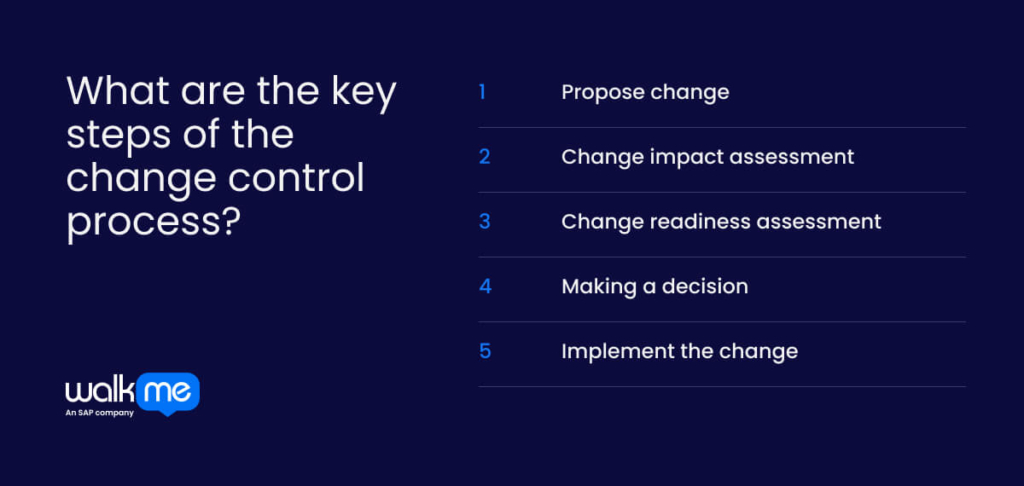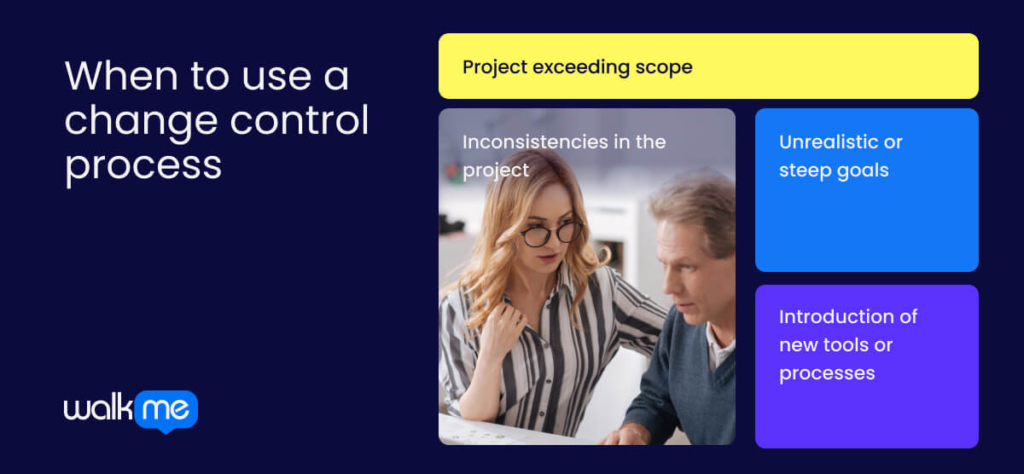In the era of rapid digital innovation, the change control process distinguishes organizations that adapt with precision from those that stumble.
Change control provides a framework for evaluating, approving, and implementing system updates, process shifts, and policy changes without compromising operations or risking the effects of change fatigue.
Research from Gartner shows that while the average organization has executed five enterprise-wide changes in the past three years, only 34% have achieved success.
The data clearly indicates that execution, rather than strategy, is where most change management challenges occur and efforts fail. Change control introduces discipline, reducing risk, maintaining business continuity, and ensuring resources are applied with intent.
This article examines the change control process, its key steps, benefits, challenges, and real-world examples, providing organizations with a framework for managing changes safely and effectively.
What is the change control process?
A formal change control process follows five essential steps. These include proposing a change, conducting an impact assessment, assessing readiness, making a decision, and implementing the change.
At its core, the change control process is a structured method for managing alterations to systems, processes, or products in a way that minimizes disruption and risk. It creates a single source of accountability by documenting requests and ensuring every decision passes through the same transparent checks before action is taken.
In the technology sector, McKinsey reports that only 26% of transformation efforts succeed, highlighting how failure often stems from inadequate control mechanisms rather than poor intent.
For example, when a cloud-based software vendor updates a database schema, change control ensures the request is logged, impacts are assessed, and leadership approves the plan. In this context, it also schedules downtime, prepares rollback steps, and audits outcomes after deployment.
Why is the change control process important?
The change control process is important because it converts uncertainty into order. It gives teams a clear path for deciding what changes to make, when, and how, preventing surprises that can halt projects or frustrate staff.
Instead of scrambling when updates collide or systems fail, organizations move deliberately, ensuring that each adjustment is practical and tested. Change control preserves business resilience, protects investments, and keeps digital workflows predictable.
Change management leaders gain confidence that changes won’t backfire, and teams understand expectations on a higher level.
In fast-moving industries, where minor errors can easily cascade, having a reliable change control process transforms potential disruption into manageable, purposeful progress.
What are the key steps of the change control process?

In dynamic organizations, successful transformation hinges on more than strategy and depends on how change is guided and managed at every stage. The following steps outline a disciplined approach that turns ideas into measurable outcomes.
Let’s take a closer look at the key steps of the change control process:
Propose change
Every organizational improvement begins with recognizing a need. Someone notices a system slowing down, a process causing errors, or an opportunity that competitors are exploiting.
Proposing a change is about turning that observation into a concrete idea with a clear purpose.
The proposal explains what needs to happen, why it matters, and what success looks like. When the reasoning is transparent, it’s easier for colleagues and leaders to engage with the idea, raise questions, and refine it. A strong proposal transforms abstract ideas into a shared understanding that can be communicated with clarity throughout the organization.
Change impact assessment
Once a change is suggested, understanding its effects across the organization is required. Each modification can ripple through processes, teams, and systems in ways that may not be immediately obvious.
Assessing impact examines what could be improved, what could slow down, and where problems might arise. For example, introducing new software may increase digital efficiency in one department while creating extra steps for another.
Exploring these effects helps prepare solutions in advance and ensures that resources are focused on the areas that need support. A thorough impact assessment means organizations move forward with confidence rather than reacting to surprises.
Change readiness assessment
Even the best-planned change will struggle if the organization isn’t ready. A change readiness assessment evaluates whether teams have the skills, tools, and understanding to adopt the change successfully. It examines culture, capacity, and timing, uncovering gaps that could cause frustration.
For example, deploying a new reporting system requires that employees know how to use it and that existing data structures can support it. Identifying challenges before launching the change means making adjustments to address them. This increases adoption rates and ensures that teams feel capable rather than overwhelmed as the organization pushes into new territory.
Making a decision
After proposals and assessments, leaders must determine the best course of action. Decisions must strike a balance between opportunity, risk, and practical feasibility. It helps ensure that the change aligns with broader goals. This step includes evaluating potential consequences, considering resource allocation, and confirming that support systems are in place.
Communicating the choice clearly is as important as the decision itself, as it creates alignment across teams and reduces uncertainty. For example, a company may decide to delay a software rollout if additional employee training or testing is required. Thoughtful decisions prevent wasted effort, protect operations, and maintain organizational alignment.
Implement the change
Implementation is the step where planning becomes action. Tasks are coordinated, timelines managed, and communication maintained to ensure everyone understands what is happening and why. Teams work together to execute the change while monitoring for issues that could derail progress.
For example, updating a cloud ecosystem requires careful scheduling, staff coordination, and post-deployment checks to confirm stability. After completion, outcomes are reviewed and lessons captured for future initiatives. Implementation should guide the organization through the entire transition. It should also safeguard continuity and ensure that improvements deliver the benefits intended without creating disruption.
Change control vs. change management
Understanding the distinction between change control and change management is necessary for organizational decision-making. Knowing how each function works ensures that change management strategies are applied correctly and outcomes are optimized.
Let’s take a closer look at change control vs. change management:
Change control
Change control is the process of overseeing specific modifications to systems, tools, or methods. It ensures each change is documented, approved, and implemented with minimal disruption. The focus is on controls, risk, and compliance, ensuring that technical adjustments occur safely and predictably within established boundaries.
Change management
Change management is the broader practice of guiding people, teams, and the organization through transformation. It addresses culture, communication, training, and adoption, helping staff understand and embrace changes. The emphasis is on people and processes rather than individual technical adjustments. It also ensures the organization transitions smoothly and achieves its strategic objectives.
What is an example of the change control process?
Seeing the change control process in action helps clarify its purpose and impact. The following real-world examples illustrate how structured steps prevent disruption and ensure modifications deliver the intended results.
Let’s take a closer look at examples of the change control process:
Software development
In 2024, Microsoft implemented robust change control processes to manage software updates and feature releases. These processes involve submitting change requests, assessing potential impacts, obtaining approvals, and scheduling deployments to minimize disruptions.
For instance, Microsoft employs a structured change control board to evaluate and authorize changes before they are pushed to production. This ensures stability and reliability in their software products.
ERP system integration
When companies like SAP assist organizations in integrating enterprise resource planning (ERP) systems, they emphasize the importance of a meticulous change control process. This includes defining change requests, obtaining approvals, and executing changes during planned maintenance windows.
For example, SAP’s implementation methodology incorporates a change control framework to manage modifications to the ERP. This means that changes align with business objectives and do not adversely affect existing processes.
Logistics and supply chain
In supply chain management, companies like FedEx have adopted change control processes to address alterations in shipping routes, inventory systems, and delivery schedules. These processes involve assessing the potential impact of changes on service delivery and implementing changes in a controlled manner to maintain service quality.
For instance, FedEx uses a change control system to monitor and approve changes to its logistics network, ensuring that any modifications do not disrupt customer deliveries.
When to use a change control process

Knowing when to apply a change control process ensures that modifications are introduced safely and effectively. Understanding the right timing is crucial for organizations to prevent disruptions and maintain operational stability.
Let’s take a closer look at when to use a change control process:
Project exceeding scope
When a project grows beyond its original intent, change control ensures every addition is managed safely. For example, introducing extra features to a software release could stretch resources or delay delivery. A structured process clarifies priorities, reallocates resources, and keeps the project aligned with its goals while preventing disruptions.
Inconsistencies in the project
If teams work in conflicting ways or produce uneven results, change control brings alignment. An example could be that differing data entry practices across departments can create errors and confusion. Applying a formal process harmonizes workflows, ensures everyone follows consistent standards, and reduces mistakes. In the long run, this maintains steady and predictable progress.
Unrealistic or steep goals
When objectives are overly ambitious, change control assesses feasibility and resource allocation demands. For example, deploying a system upgrade in half the usual time could overburden staff and compromise quality. The process provides a structured way to adjust timelines or resources, balancing ambition with practical execution for realistic success.
Introduction of new tools or processes
Adding new software or procedures can disrupt current operations if not managed carefully. For example, launching a new CRM system requires staff preparation, testing, and adjustments to the workflow. Change control evaluates readiness, plans implementation, and communicates changes clearly. It also ensures that digital adoption is smooth and that teams remain confident and productive throughout the transition.
What are the benefits of the change control process?
A structured change control process delivers more than order. It safeguards operations and maximizes the success of modifications. Understanding its benefits helps organizations ensure that every change contributes positively to strategic goals.
Increased productivity
Change control helps teams focus on what really matters. When every task is planned, approved, and scheduled, employees spend less time fixing mistakes or redoing existing work. For example, scheduling a software update properly means fewer emergency fixes and faster progress, allowing teams to accomplish more in less time.
Effective communication
A clear change process makes sure everyone knows what’s happening and why. Sharing updates, approvals, and next steps keeps teams on the same page. For example, when departments see the full picture of a new tool, misunderstandings decrease, questions are answered quickly, and work flows without confusion.
Better teamwork and collaboration
Change control shows who is responsible for what and how tasks are interconnected. For example, IT, operations, and support teams can coordinate a system upgrade to avoid conflicts and support one another. Clear roles and shared information make it easier to work together and achieve goals, building digital trust and cooperation across teams.
What are the challenges of the change control process?
Even the best-designed change control process faces hurdles that can slow progress or create digital friction. Understanding these challenges enables organizations to anticipate risks, address obstacles, and maintain control when implementing modifications.
Let’s take a closer look at the challenges of the change control process:
Opposition to the change
Resistance from staff or leaders can slow or derail a change. For example, employees may worry that a new system will make their work harder or threaten routines. Change control must address concerns, involve stakeholders early, and explain benefits. This will help reduce pushback and ensure a smooth implementation.
Extended approval periods
Lengthy approval processes can delay progress, especially when multiple teams or managers must sign off. For instance, a software update may sit waiting for authorization, causing project slowdowns or missed opportunities. Effective change control balances thorough review with timely decisions to keep initiatives moving without compromising quality or safety.
Insufficient documentation or communication
When change requests or instructions are unclear, teams risk mistakes and confusion. For example, implementing a new workflow without clear guidance can lead to massive errors. Comprehensive documentation and open change management communication ensure that everyone is aware of their responsibilities, timelines, and expectations. This, in turn, helps keep the change process efficient and accountable.
How to implement the change control process
This article has shown you what change control entails, why it matters, and how it functions in real-world settings. It has also highlighted the challenges, benefits, and scenarios where structured oversight makes a big difference.
Implementing the change control process begins with identifying the change and understanding its effects on people, workflows, and system integration. Next, assess readiness and ensure teams have the critical employee skills, tools, and capacity to adopt the change without disruption.
Decisions should be based on transparent evaluation, considering risks, contingencies, and alignment with strategic objectives. Once approved, changes are introduced methodically, with ongoing communication and thorough documentation to ensure a seamless implementation.
Progress is then monitored, feedback is gathered, and small adjustments are made to keep the process on track.
Following these steps transforms change from a source of uncertainty into a controlled and predictable process. It allows organizations to adapt confidently and achieve tangible outcomes with each modification.
FAQs
A Change Control Board usually includes managers, team leads, and key stakeholders from affected areas. For example, IT and business representatives review proposed changes together. Their role is to assess risks, approve or reject requests, and ensure changes align with goals, keeping processes safe and organized.
Organizations often use platforms like Jira, ServiceNow, or SAP Solution Manager to track and manage changes. These tools log requests, monitor approvals, schedule implementations, and document outcomes. They provide transparency and accountability, making it easier for teams to coordinate and follow the change control process.
Urgent changes follow an expedited process with immediate review and approval by key stakeholders. For example, fixing a critical system outage may require bypassing some steps. Even so, documentation, communication, and post-implementation review remain essential to ensure the change doesn’t create new risks or disrupt operations.

